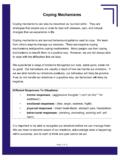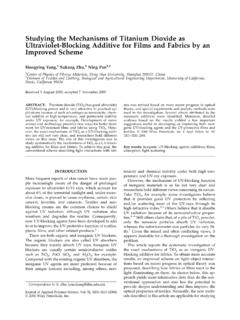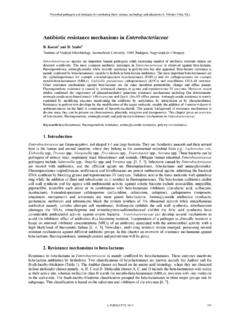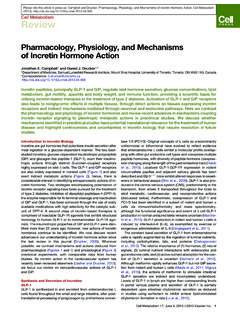Transcription of Respiratory tract defense mechanisms Ciliary …
1 1 Respiratory tract defense mechanisms Upper airway Mechanical barriers Nasal turbinates Glottis Reflexes Cough, sneeze Maintenance of oropharyngeal flora Saliva Bacterial competition Naturally occurring bacterial binding site analogues Local immunoglobulins Lower Airway Branching airways Mucociliary escalator Alveolar space defenses Alveolar lining fluid Free fatty acids Lysozyme Iron-binding proteins IgG Surfactant Cellular components Macrophages Polymorphonuclear cells LymphocytesMechanical lung host defenses The nose and mucociliary transport systems comprise the main mechanical defense system of the lungs Particles greater than 10 microns settle in the upper airways and rarely enter the lower airways Particles between 5-10 microns deposit in the trachea and main bronchi and can be removed by mucociliary transportCiliary structure and function 9 + 2 microtubule structure Major proteins.
2 Tubulin and dynein Ciliary beat frequency 12-15 Hz2 The cilia are partially covered by a mucous sheet. Stimulators and inhibitors of Ciliary function Increase Ciliary beat frequency beta-adrenergic agonists (via adenylate cyclase, cAMP, and protein kinase A pathways Anticholinergic agents (via protein kinase C pathways) Increase in intracellular Na+/Cl- ratio Decrease Ciliary beat frequency Neuropeptide Y, major basic protien Bacterial products (pyocyanin, 1-hydroxyphenazine, and others)Diseases associated with abnormal Ciliary function Primary Ciliary dyskinesia; immotile cilia syndrome; Kartagener s syndrome; autosomal recessive Young s syndrome: sinusitis, bronchiectasis, obstructive azospermia; ? location of defect Cystic fibrosis; autosomal recessive Chronic bronchitisTobacco smoke and Ciliary structure and function Smokers and ex-smokers have a higher level of Ciliary structural abnormalities (17% of cilia) than never smokers ( ) Verra F et al.)
3 Ciliary abnormalities in bronchial epithelium of smokers, ex-smokers, and nonsmokers. Am J Respir Crit Care Med 1995;151:630-4 Ciliary beat frequency is not diminished by age, but is decreased similarly in smokers and those exposed to environmental tobacco smoke Agius et al. Age, smoking and nasal Ciliary beat frequency. Clin Otolaryngol 1998; 23: 227-30 SEM of terminal bronchioles and alveolar ducts3 Humoral immune functions of the lung Lymphocytes in the lung are found in submucosal collections known as bronchial associated lymphoid tissue (BALT); Ig may also diffuse into the lung IgG, IgA, and IgE are all present in measurable amounts in the lung IgA, IgG3and IgG4are present in greater concentration in the lung than in serum IgG and IgA contribute significantly to defense against infection in the lungAbsolute and relative concentrations of immunoglobulin species in serum and BAL *BAL**ratio[BAL/serum]*mg/mL** g/mLHumoral immunodeficiency syndromes and the lungSyndromeAbnormalityAge of onsetOrganismsCausinginfectionBruton s X-linkedAgamma-globulinemiaIgG < 200mg/dlIgA, IgM, IgE,IgD absentinfancyS.
4 PneumoniaeH. influenzaeS. aureusCommon VariableImmuneDeficiencyIgG<300mg/dlIgA, IgM low;antibody responses to vaccinesimpairedadulthoodsame as aboveHumoral immunodeficiency syndromes and the lungSyndromeAbnormalityAge of onsetOrganismsCausinginfectionIgA deficiencyIgA < 5 mg/dladulthoodsimilar to CVID, but much less severeIgG subclassdeficiencymost severeclinically withIgG1, IgG3adulthoodsimilar to CVIDM 4 Cellular immune defenses of the lung Alveolar macrophages: 95% of cells recovered by BAL Dendritic cells: of cells recovered by BAL Lymphocytes: 1-2 % of cells recovered by BAL CD4+ T cells CD8+ T cells Neutrophils: not present in healthy lungs; recruited to the lung by a variety of stimuliAlveolar macrophages The resident immune cell of the alveolar space Derived from bone marrow precursors, by way of the blood monocyte Proliferation may occur in the interstitium and alveolar space Key roles: phagocytosis and immune interactionsCytokines and other bioactive substances released from alveolar macrophages Arachidonate metabolites Thromboxane A2 PGE2, D2, F2 LTB4 5-HETE Cytokines/chemokines IL-1, IL-1RA IL-6 TNF- IFN- / Reactive oxygen species O2- H2O2 Hydroxyl radical Nitric oxide Constituitive Inducible?
5 Enzymes Metalloproteinases Elastase Procoagulant activityReceptors expressed and ligands recognized by alveolar macrophages Immunoglobulins (Fc receptors) IgG1, IgG3, IgE, IgA Protein, cytokine, and matrix receptors Fibronectin, fibrin, lactoferrin, transferrin, GM-CSF, IFN- , IL-2, IL-4, IL-1, IL-1RA Adhesion molecules and other receptors MHC-II, CD4, CD1, CD18 ( -integrin), CD29 -integrin), ICAM-1, CD14 (LPS) Complement receptors C3b, C4b, C3d, C5a Lectin receptors alpha-linked galactose receptors, N-acetylgalactosamine residues, a-linked fructose residues, mannose residuesNKTH1TH2M ++-IL-12 IFN- IFN- --IL-4IL-10IL-4IL-10O2 NOTNF- .Syndromes associated with impaired cellular immune function in the lungSyndromeDefectInfectionsChronic granulomatousdiseaseLoss of Respiratory burstof macrophagesencapsulatedorganisms,GNRAIDS corticosteroid usetransplant-relatedimmunosuppressionDe creased T-cell numberand functionparasitesmycobacteriafungi5 Infectious pulmonary complications of HIV infection CD4+ T-cell count >250/mm3 Bacterial pneumonia Reactivation tuberculosis CD4+ T-cell count <250/mm3 Pneumocystis carinii pneumonia Primary tuberculosis Fungal infections: Cryptococcus Geographic fungus Aspergillus spp.
6 CMV pneumonitisUnderstanding the human host response to tuberculosis Development of adjunctive immunotherapy for tuberculosis: Treatment of drug resistant organisms Shorten duration of treatment for drug susceptible disease Identify correlates of immunity to M. tuberculosis infection and disease Predict success of candidate vaccines Identify new diagnostic approaches Th1-type responseIFN- IL-2Th2-type responseIL-4IL-5IL-10 Protective immunityImpaired immunityLung-specific host responses in pulmonary tuberculosisHypothesis: clinical manifestations of tuberculosis are affected by the local immune response elicited by M. tuberculosisStudy design: BAL performed on patients with active, untreated, pulmonary tuberculosis cells and BALF obtained from one radiographically involved and one uninvolved lung segment cell count and differential performed on samples aliquot of cells (106/ml) cultured for 24 hr in serum-free RPMI and supernatants assayed for TNF- , IL1- , IFN- , TGF- AJRCCM 1998; 157: 729-735 Local cellular immune responses in patients with pulmonary tuberculosisBAL cellsno.
7 Of +smear +cavitary CXR>80% macrophages10662>20% lymphocytes8200>20% PMN132127 AJRCCM 1998; 157: 729-735 Local IFN- production in lymphocyte predominant pulmonary tuberculosis involveduninvolved[IFN-g]per106lymphocyt es(pg/ml)01000200030004000 AJRCCM 1998; 157: 729-7356 Interferon- as adjunctive immunotherapy for MDR-TB Hypothesis: interferon- may aid outcome in MDR-TB by improving host defenses against M. tuberculosis Study design: patients: smear positive MDR-TB despite documented compliance with best possible medical regimen adminstration of IFN-g: drug given as 500 mg dose via aerosol nebulizer for 4 weeks data collection: weekly vital signs, symptoms, sputum smears and cultures; HRCT and BAL at beginning and end of treatmentLancet 1997; 349: 1513-1515 Sputum AFB smear results in MDR-TB patients after IFN- Drug rxDurationof drug rxAFB Smear resultsPatient /12345 Pre-rxPost-rxcipro, capreo,clofazamine, rifabutinINH, oflox,cyclo, ethionamidecapreo, cipro, PZA,cyclo, ethionamideethambutol, PAS,oflox, ethionamide, capreoPAS, cyclo, amikacin,ethionamide, clofazamine24 months++-12 months++-13 months++++-10 months+-5 months+++-Lancet 1997.
8 349: 1513-1515 This electron micrograph shows a portionof an alveolar II cell in the terminus of the lungair passage way. Note the surfactant granules (S)within its cytoplasm. 7 This electron micrograph is of thelining of the trachea; the pseudostratified,ciliated columnar epithelial cells arebordering the lumen of the lung AE2 cells. (a) Scanning electron micrograph of human lung. Two AE2 cells (P)are seen to protrude above the largely smooth alveolar epithelial surface. A pore ofKohn (K) and the cell cell junction (arrowheads) between two AE1 cells are denoted.(b) Transmission electron micrograph of human AE2 cell displaying typicalultrastructural features, such as lamellar bodies (Lb) and apical microvilli (arrows).Nu = EM of tracheal wall8 Normal bronchus, low power9 Pseudostratified columnar epithelium

















